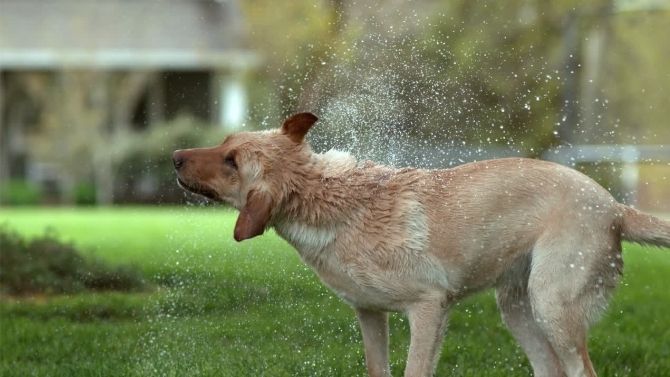If there’s one thing that has had me pacing around my living room, it’s when I’ve spotted my puppy shaking for the first time.
I remember one particularly rainy afternoon, my buddy Max, a sprightly Golden Retriever, suddenly began trembling from nose to tail. My immediate thought was, “Has he caught a cold? Is it something he ate?”
Thankfully, it turned out he was just a bit shaken by the loud thunderclap. But that event set me off on a journey to understand why dogs shake, when it’s a cause for concern, and what we can do to help.
In this guide, I’ve put together all that I’ve learned in hopes of shedding light on this mysterious canine behavior.
It Can Be Completely Natural!
Dogs have a range of natural behaviors that they exhibit in response to their environment. Shaking can be one of these. They might shake to shed water from their fur or as a quick stretch after a nap.
It’s similar to how we might shiver momentarily when we’re chilly or shake out our hands after a period of inactivity.
Shaking as a Part of Emotional Response

Dogs are highly emotional creatures. They can shake or tremble in response to various emotional states, such as excitement, anxiety, or fear.
For instance, a dog might shake with anticipation when you’re about to throw their favorite ball or tremble during a thunderstorm because they’re scared.
Medical Reasons Behind It
While many reasons for a dog’s shaking are benign, some could be indicative of medical issues. It’s essential to be vigilant and understand when shaking might be a sign of a more significant problem.
1. Pain and Discomfort
Just as we might shudder or grimace when we’re in pain, dogs can shake or tremble when they’re experiencing discomfort. This could be due to anything from a minor injury to internal issues.
Look for other signs of distress, such as limping, whining, or changes in behavior, to determine if pain might be the cause.
2. Diseases and Conditions
Certain diseases, like distemper or kidney disease, can cause shaking. Additionally, conditions such as hypoglycemia (low blood sugar) or seizures can lead to noticeable tremors.
If your puppy’s shaking is accompanied by other symptoms like lethargy, disorientation, or changes in appetite, it’s essential to consult a veterinarian.
Environmental and External Factors

Not all causes of shaking are internal. Often, the environment or external stimuli can be the culprit behind your pet’s tremors.
Temperature and Climate
Dogs shake when they’re cold, just as we might. While many dogs shake for various reasons, there are certain breeds that have a natural predisposition to tremble more frequently.
It’s essential to ensure your dog has a warm shelter during colder months and consider doggy sweaters or jackets for those especially chilly walks.
Exposure to Toxins
Dogs are curious creatures and might ingest or come into contact with substances that aren’t good for them.
Shaking can be a sign of poisoning, especially if paired with symptoms like drooling, vomiting, or lethargy. Common toxins include chocolate, certain plants, and household chemicals.
Behavioral Aspects
Dogs are complex beings, and their behavior is influenced by past experiences, training, and social dynamics. Understanding the behavioral roots of shaking can help address and alleviate the issue.
Training and Past Traumas
Dogs that have had negative experiences might shake when they’re reminded of those traumas. For instance, a dog that was punished with a spray of water might shake when they see a water bottle.
Positive reinforcement training and patience can help mitigate these responses over time.
Social Dynamics and Interactions
Just as humans feel nervous in certain social situations, dogs too might shake when they’re uncertain about their surroundings or the animals and people they encounter.
This could be due to inadequate socialization during their puppy years or negative interactions with other animals.
Age-Related Shaking

As dogs age, their bodies undergo changes, and some of these changes might manifest as shaking. Recognizing and addressing age-related issues can help in ensuring your senior pet remains comfortable.
Neurological Changes
Senior dogs, especially those in their advanced years, might suffer from conditions similar to Parkinson’s in humans. This can result in tremors or shaking.
While the condition isn’t painful, it’s essential to ensure that the dog is comfortable and safe, especially when navigating their environment.
Muscular and Joint Issues
As dogs age, they often develop muscular and joint problems that can significantly impact their quality of life. Arthritis and muscular atrophy are two prevalent conditions that older dogs commonly face.
Arthritis, in particular, is a degenerative joint disease where the cartilage between bones gradually wears down, leading to:
- Inflammation
- Stiffness
- Pain
One of the most noticeable senior dog arthritis symptoms includes difficulty standing up, reluctance to climb stairs, or an unwillingness to jump onto furniture. In severe cases, your dog might even display a limp or start shaking due to the discomfort caused by inflamed joints.
Muscular atrophy, on the other hand, involves the weakening or wasting away of muscle tissue, often seen in the hind legs. It can happen because the pain associated with arthritis discourages movement, leading to decreased muscle mass over time.
The resulting weakness can cause your senior dog to tremble, especially after physical activity or when they try to maintain a standing position for extended periods.
To manage these age-related ailments, regular vet check-ups are essential to monitor your dog’s joint health and overall well-being. Joint supplements, such as glucosamine and chondroitin, can be beneficial in reducing inflammation and slowing cartilage degradation.
A regimen of tailored low-impact exercises, like short walks or swimming, can help maintain muscle strength without putting too much stress on the joints. Ensuring your dog maintains a healthy weight is also crucial, as excess weight can exacerbate joint pain and mobility issues.
How to Solve This?
Discovering the reason why your puppy might be shaking is half the battle. Knowing how to care for your pup in these situations is just as crucial.
Veterinary Intervention

If the shaking is due to a medical issue, early diagnosis and treatment are key. Regular vet visits, coupled with an observant pet parent, can ensure that issues are addressed promptly.
Sometimes, medications or specialized diets can make a world of difference.
Provide Comfort and a Safe Environment
Creating a safe and comfortable environment for your dog can alleviate many causes of shaking. This might mean a warm bed, toys to alleviate anxiety or a quiet space for them to retreat to during loud events.
Additionally, if toxins are a concern, ensure that harmful substances are out of their reach.
FAQs
Is there a difference between occasional shaking and frequent tremors in dogs?
Yes, there is. Occasional shaking could be a reaction to a temporary stimulus or feeling, such as getting wet or being momentarily startled.
Frequent tremors, on the other hand, are consistent and may indicate an underlying health or behavioral issue. It’s essential to monitor the frequency and context of the shaking to determine its cause.
Can certain breeds be more prone to shaking than others?
Yes, some breeds, especially smaller ones like Chihuahuas or Toy Poodles, can be more prone to shaking. This could be due to a combination of physiological and temperament factors.
However, any persistent shaking, irrespective of breed, should be monitored for potential underlying causes.
My dog only shakes during vet visits. Why could this be?
This is likely due to anxiety or fear. Veterinary clinics have unique smells, sounds, and experiences that might be stressful for some dogs. Over time, they can associate the clinic with these feelings, leading to shaking during visits.
To mitigate this, positive reinforcement and gradual desensitization can help make vet visits less stressful.
Is shaking the same as twitching in dogs?
Not necessarily. While both involve involuntary muscle movements, twitching is usually localized to a specific area, such as a leg or the tail, and might be due to muscle spasms or irritation.
Shaking, on the other hand, usually involves larger parts or the entirety of the dog’s body. It’s crucial to differentiate between the two to identify potential causes.
Can diet influence a dog’s tendency to shake or tremble?
Absolutely. A diet lacking in essential nutrients or one that’s not suitable for a particular dog can lead to issues like hypoglycemia, which can result in shaking.
Always ensure your pet’s diet is well-balanced and consult with a vet if you’re unsure about dietary choices.
How can I distinguish between harmless shaking and a potential seizure in my dog?
Seizures are usually accompanied by other symptoms such as drooling, foaming at the mouth, loss of consciousness, or involuntary urination.
The movements during a seizure are often more intense and erratic compared to regular shaking.
If you suspect your pet is having a seizure, it’s crucial to consult a veterinarian immediately.
Summary
Reflecting back on that rainy day with Max, I realize that our journey with our dogs is filled with moments of concern, joy, and learning.
The whole situation has been enlightening, and I’m glad I could share this knowledge with all of you.
Remember, our pups look to us for care, comfort, and understanding. It’s up to us to be observant, to learn, and to provide the best for them.






